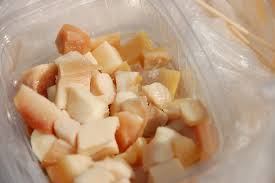

Shark fishing goes as far back as 700 years ago. It was an important food and valuable export for Iceland. This was because the shark liver oil was used to light lamps in Copenhagen. Once the shark liver oil was no longer value the importance of this food started to decline. It is still considered a traditional food of Iceland. Commonly served during the Þorri festival. The shark is poisonous to eat if not properly prepared. This preparation is for it to be properly aired and sometimes boiled. If the fermentation process is not done correctly it could lead to someone’s poor health. Fermented shark is semi-dried Greenland shark. The fermentation process takes 3-6 weeks and the shark is cut up and stored in an outdoor container with holes in the bottom for drainage. The traditional process was done with the shark in a pit in the ground. Some of the cultural perspectives of this food are that while it is pretty common in Iceland, it’s a national delicacy, it doesn’t mean that everyone there has chosen to taste this traditional food. The fermented shark was introduced during a time when food options were limited for Iceland, this was due to the harsh climate and lack of excess to other trade routes. This made all types of sea life a large part of the Icelandic diet. While this dish is now a common site and can be seen in most establishments, from restaurants to the grocery store, it is still considered traditional food. It is commonly served during the Þorri festival, a festival that celebrates Iceland’s history, and commonly a time to prepare traditional foods. When this festival started it started from the time that most foods had to be pickled and fermented, in order for the people of Iceland to survive. While this is a common food at this point in time, there are some Iclandic people who choose not to indulge. This could be becasue of the rancid smell. Most Icelandic people don’t regularly indulge in this food, and it is a common food at this point, yet this could be because of the rancid smell. The scent of the shark is supposed to be worse than the actual taste. If you can get past the scent the taste is said to be quite pungent. This food is not commonly recommended for visitors. Yet, if you’re brave enough give it a try. It is regularly served in cubes with a toothpick, like an hors-d'oeuvre. The shark that is usually caught to make hákarl is the Greenland shark. This shark can be up to 23 feet and can live to be about 400-500 years old. They are slow-moving sharks and not dangerous to humans. This is partly because they live in deeper waters than where people swim, yet this has not stopped the sharks lives from being in danger. With them once being fished to make liver oil and still being fished today in order to make fermented shark, they are not yet an endangered species. They are however near threatened. This just means that they are very close to the possibility of being an endangered species. With the continued fishing of these sharks to eat it could lead to them becoming extinct. Is continuing to eat this traditional food really worth it?

